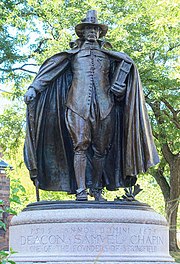
Back تاريخ البيوريتانية في أمريكا الشمالية Arabic História dos puritanos na América do Norte Portuguese
| Part of a series on |
| Puritans |
|---|
 |
In the early 17th century, thousands of English Puritans settled in North America, almost all in New England. Puritans were intensely devout members of the Church of England who believed that the Church of England was insufficiently reformed, retaining too much of its Roman Catholic doctrinal roots, and who therefore opposed royal ecclesiastical policy. Most Puritans were "non-separating Puritans" who believed there should be an established church and did not advocate setting up separate congregations distinct from the Church of England; these were later called Nonconformists. A small minority of Puritans were "separating Puritans" who advocated for local, doctrinally similar, church congregations but no state established church. The Pilgrims, unlike most of New England's puritans, were a Separatist group, and they established the Plymouth Colony in 1620. Puritans went chiefly to New England, but small numbers went to other English colonies up and down the Atlantic.[1]
Puritans played the leading roles in establishing the Massachusetts Bay Colony in 1629, the Saybrook Colony in 1635, the Connecticut Colony in 1636, and the New Haven Colony in 1638. The Colony of Rhode Island and Providence Plantations was established by settlers expelled from Massachusetts because of their unorthodox religious opinions. Puritans were also active in New Hampshire before it became a crown colony in 1691. Puritanism as a powerful force weakened early in the 18th century and before 1740 was replaced by the much milder Congregational church.
- ^ Kopelson